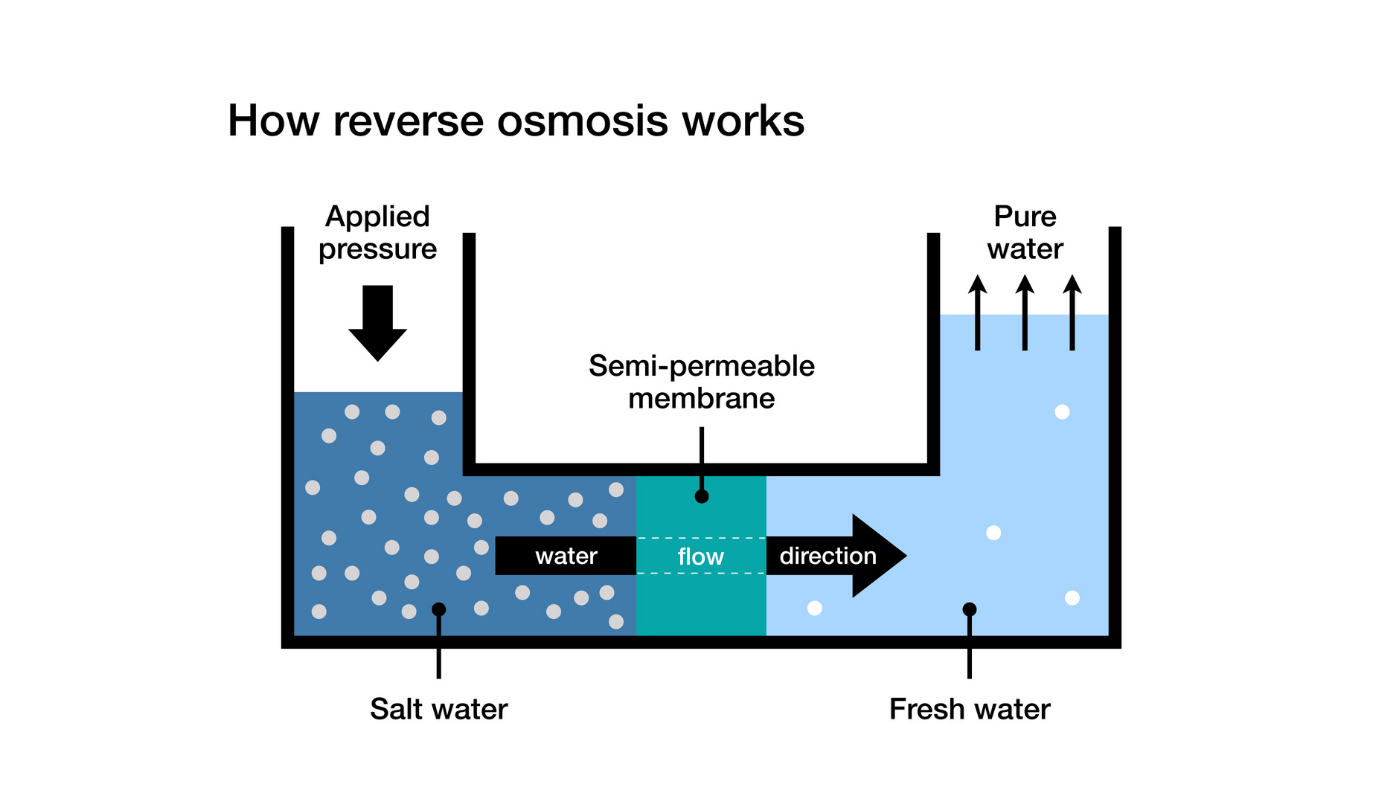
How Reverse Osmosis Works in Countertop Water Dispensers
Ever wondered how your countertop water dispenser turns questionable tap water into pure refreshment? Reverse osmosis (RO) is the magic behind it, using a quality filtration performance process to remove contaminants, leaving only clean, great-tasting water. Want to know how it works—and why it’s worth it? Let’s dive in! 🚰✨
Understanding Reverse Osmosis: The Basic Principles
What is Reverse Osmosis?
Reverse osmosis (RO) is a highly effective water purification process that removes contaminants by forcing water through a semi-permeable membrane. Imagine a bouncer at a VIP club. Only the cleanest, purest water molecules make it past the velvet rope, while the bad stuff—like heavy metals, chemicals, and bacteria—gets kicked out. The result? Exceptionally clean drinking water that’s free from harmful pollutants.
Osmosis vs. Reverse Osmosis
To understand reverse osmosis, let’s first talk about osmosis—the process nature uses to move water. Plants use osmosis to absorb moisture from the soil, and our bodies use it to regulate hydration. But reverse osmosis flips the process. Instead of water naturally flowing from a weaker concentration to a stronger one, RO uses pressure to push water in the opposite direction, forcing it through an ultra-fine membrane. Think of it like swimming against the current in a river—except the river is full of contaminants, and only the cleanest water makes it through.
The Role of the Semi-Permeable Membrane
At the heart of reverse osmosis filtration is the semi-permeable membrane—a microscopic filter with pores so tiny (about 0.0001 microns) that almost nothing but pure water can pass through.
This high-tech barrier removes:
✅ Heavy metals (lead, mercury, arsenic)
✅ Bacteria and viruses
✅ Dissolved salts and chemicals
✅ Pesticides and pharmaceutical residues
Everything that doesn’t belong in your drinking water is flushed away, leaving only clean, great-tasting hydration.
Reverse Osmosis Filtration Process
Size, Filtration, and Purification Explained
RO filtration performance is all about multi-stage purification. A typical countertop RO water dispenser includes:
1️⃣ Pre-filtration – Removes sediment, chlorine, and larger contaminants
2️⃣ RO membrane filtration – Blocks microscopic pollutants
3️⃣ Post-filtration – Polishes the water for improved taste and clarity
Each stage plays a crucial role in ensuring your water is ultra-pure and safe to drink.
Production of Pure Water and Brine
RO doesn’t just create clean water—it also produces brine, a fancy word for wastewater.
💧 Purified water – What you drink, free from contaminants
💦 Brine (wastewater) – The unwanted substances, flushed away
Older RO systems were notorious for wasting too much water, but modern models have features to reduce waste and improve efficiency.
The RO Process in Countertop Dispensers
Pre-Filtration Stage
Before reaching the RO membrane, water first passes through pre-filters to catch larger contaminants.
Sediment and Carbon Filters
- Sediment filters remove dust, dirt, rust, and sand, preventing the RO membrane from clogging.
- Carbon filters trap chlorine, volatile organic compounds (VOCs), and odours, making the water taste and smell better.
Without these pre-filters, the RO membrane wouldn’t last long!
RO Membrane Filtration
How the Membrane Filters Contaminants
Now comes the magic moment—water reaches the RO membrane and undergoes high-pressure filtration. This step removes:
✔ Heavy metals and dissolved salts
✔ Microplastics and chemical residues
✔ Bacteria and viruses
Only pure H₂O molecules make it through, while everything else is flushed away.
Tankless vs. Tank-Based Systems
- Tank-based RO systems store purified water for quick dispensing.
- Tankless models filter water on demand, reducing wastewater and saving space.
Which is better? Tank-based units provide instant access to filtered water, while tankless models are compact and efficient.
Post-Filtration Stage
Final Polishing Filters
To ensure great taste and clarity, RO systems add a final filtration stage.
This is usually an activated carbon filter or UV sterilisation, removing any last traces of contaminants.
Taste and Odour Improvements
Ever noticed how RO water tastes fresher and cleaner? That’s because it eliminates:
❌ Chlorine and chemical residues
❌ Sulphur and metallic aftertastes
❌ Unpleasant odours
Some advanced RO dispensers also add minerals back to improve flavour and health benefits.
Types and Features of Countertop RO Systems
Countertop vs. Under-Sink Systems
| Feature | Countertop RO | Under-Sink RO |
|---|---|---|
| Installation | Plug-and-play | Requires plumbing |
| Size | Compact | Larger unit |
| Portability | ✅ Yes | ❌ No |
| Price | Lower | Higher |
| Filtration Quality | High | High |
Practical Features for Daily Use
Water Quality Indicators
Some modern models include LED indicators to show:
✅ When water is safe to drink
⚠️ When it’s time to replace the filter
Filter Replacement Alerts
No more guessing games! Smart RO systems alert you when filters need changing, ensuring peak filtration performance.
Pros and Cons of RO Dispensers
Advantages of RO Water Dispensers
High Purity and Improved Taste
RO filtration removes up to 99% of contaminants, giving you:
✔ Healthier, better-tasting water
✔ No chlorine or metallic aftertaste
Health and Environmental Benefits
- No plastic waste from bottled water
- Removes chemicals linked to health risks
- Cuts down on single-use plastic reliance
Disadvantages and Considerations
Water Waste and Efficiency Concerns
Older RO systems wasted a lot of water, but newer models have waste-reduction features to improve efficiency.
Space and Installation Requirements
- Countertop models need some counter space.
- Under-sink systems require permanent installation.
Maintenance: Keeping Your System Efficient
Regular Filter Changes
| Filter Type | Replacement Schedule |
|---|---|
| Sediment filter | Every 6-12 months |
| Carbon filter | Every 6-12 months |
| Post-filter | Every 12 months |
RO Membrane Lifespan
The RO membrane lasts 2-3 years, depending on water quality and maintenance.
System Cleaning and Sanitisation
Preventing Bacterial Growth
- Regularly clean the storage tank
- Use UV sterilisation if available
Descaling and Practical Maintenance Tips
- Hard water? Descaling prevents mineral build-up.
- Follow the manufacturer’s guide for the best performance.
Final Thoughts: Should You Get a Countertop RO Dispenser?
If you want clean, pure, and great-tasting water, a countertop RO dispenser is a fantastic investment. It’s cost-effective, eco-friendly, and removes contaminants better than standard filters. Want to upgrade your water quality? An RO dispenser could be exactly what you need! 🚰✨
More Countertop Water Dispenser info we think you'll love
Well Water Woes? Find the Perfect Countertop Dispenser for Clean, Safe Water
Best Countertop Water Dispensers for Hard Water: Top Picks & Tips
Activated Carbon Filtration: What It Removes and How It Works
UV Purification: How Light Disinfects Your Countertop Water
Sediment Filtration: Protecting Your Countertop Water Dispenser
Understanding Filter Pore Size: What It Means for Your Countertop Water


Leave a comment